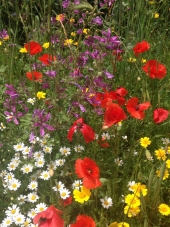""Thanks Rue, I shall heed your warnings about introducing new species. Please tell me what plants/cover you have growing after your spring flowers die off? ""
Your biggest problem will be lack of water. YOu mentioned a dry stream. I don't know about yours, but in summer, all of our streams are dry. The only times they flow are about a couple weeks after significant rains. And then they dry again.
If you want to establish trees in our climate type, you'll most likely have to get minimal water to them while their roots become established the first year or two. Or longer.
I am not a farmer or permaculturist. I have mainly veggie beds and some fruit trees (citrus/figs/peach/plum, apricot, avocados). And these all require some water in the long, dry summers or they simply do not prosper.
You ask what plants I have growing after the spring flush. No annuals unless they are in watered beds. I do use covercrops, but those require water to germinate and grow in summer. Right now I'm planning to plant more going into our rainy season (usually November it starts), but will water them to get them started. Rains are not dependable.
The species I am using I'm still experimenting. Rocket/arugula does great and reseeds. Buckwheat, and come extra garden cole seeds, Brassicas and radishes, even grocery store lentils. Sunflowers too. Vetch (Vicia Villosa) is naturalized in the area. We also have lots of annual Mediterranean grasses that have become totally naturalized, which I welcome in my beds. Also some native flowers such as California poppies.
Two problems with annual cover crops here (besides water issues). The bunnies and ground squirrels and birds eat the seedlings when there is nothing else green to eat. And if you are thinking they will reseed, the birds and mice eat much of the seed that falls. so when you see dry seed heads, collect them.
There are some African daisies that do well without water all year and are pretty in springtime, but once you plant them, you will have them forever. Also some low-growing Aloes which seem to be no problem. Lantana prospers as well, blooms all year, attracts pollinators, and is very drought tolerant. Does not reseed much, but can be started by cuttings. There are both shrub and prostrate varieties, with color variety.
There are some California native varieties the industry has developed, which should grow there, but they do not seem to live a long time. I'd think something like Rosemary would be good, and some of the other sages would work. Rosemary is a common landscaping plant here. Low and veyr drought tolerant.
It's a great climate to be living in, but the lack of water does present a major challenge when establishing plants.







